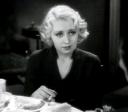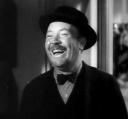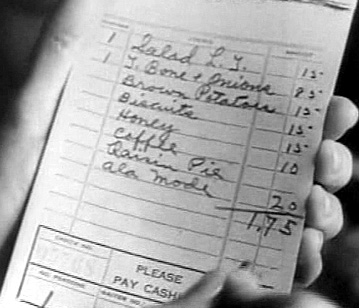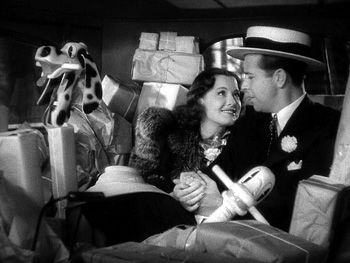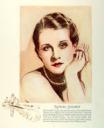Since I’ve been busy for the past few days (not to mention that my brain feels like it’s completely fried out from work), I’ve become semi-obsessed with movies that run from about 60-75 minutes in length. I think they’re what the studios used to call “programmers”: b-movies that were the second feature on the bill, usually made in a short amount of time and with stock members of the studio’s acting stable. I’ve seen quite a few in the last couple of days–I find they fill in the space quite nicely between eating dinner and getting caught up on the latest Governor sex scandal.
One of my favorites is 1932’s Union Depot, a Warner Brothers’ effort that stars Douglas Fairbanks Jr. and Joan Blondell. Since it’s a depression era pre-code, you get all the trimmings: there’s Ruth (Blondell), a chorus girl who’s down on her luck, bums (Fairbanks and Guy Kibbee), a drunk (the lovable Frank McHugh), a counterfeiter on the lam (Alan Hale) and not one, but two sleazy sub-plots! Hurray!
Fairbanks and McHugh, Blondell and Kibbee. The latter three are standard in any early 30’s WB movie.
Union Depot is reminiscent of 1932’s Grand Hotel, except that it’s set in a train station and we’re treated to the exploits of the poor, instead of the rich. What I particularly enjoyed were the many subplots that managed to weave together by the end of the film. Since it’s a pre-code, the amount of sex is fairly shocking: when Ruth needs money, she’s willing to prostitute herself out to Chick (Fairbanks), a bum who’s posing as a rich guy thanks to the contents of a suitcase that the drunken McHugh left behind. However, Ruth can’t bring herself to do it and after having a change of heart, Chick decides to play “Sant-y Claus” and help her out. Ruth also has a deliciously twisted back story, which involves a perverted old man that she used to read dirty books too. She thought he was blind–he wasn’t, and when he whipped off his glasses and revealed a pair of evil eyes, Ruth ran for her life. Now, the pervert is hot on her trail and unbeknownst to Ruth, has followed her to Union Depot.
One of the scenes I got the biggest kick out of was in the diner where Chick orders a meal. When he places an order for “a nice tomato salad, a thick sirloin steak smothered in onions, some browned potatoes in creamed gravy, a flock(?) of hot biscuits and some honey, coffee and raisin pie a la mode”, you can only imagine what a meal that sumptuous would cost in 1932. Ready to find out? Here it is:
Using this calculator, that meal would now cost a person $26.56. So back in those days, $2 was equivalent to $30 today. Talk about inflation! I’m always fascinated by the price of food in classic movies. It’s shocking to see a grocery store sign touting that a loaf of bread costs ten cents, while in today’s world, a loaf of bread is fifteen to twenty times that much! It insane.
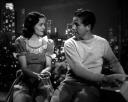 Money is also a huge factor in Preston Sturges little known comedy, Christmas in July (1940). Like Union Depot, it’s also another “programmer”, this time starring Dick Powell and Ellen Drew, as well as Franklin Pangborn and Sturges’ favorites, William Demarest and Frank Moran. Jimmy (Powell) and Betty (Drew) are a working class couple who spend their evenings sitting on the rooftop of their tenement, listening to the radio. Jimmy is obsessed with winning a coffee slogan contest that he entered, and while Betty doesn’t exactly get his entry (“If You Can’t Sleep at Night, it isn’t the Coffee–It’s the Bunk!”), they both dream about the $25,000 prize money that would change their lives. When Jimmy’s co-workers trick him into thinking he’s won the contest via fake telegram, he and Betty go on a huge shopping spree where Jimmy finally buys Betty an engagement ring, as well as gifts for all their neighbors and a state-of-the-art davenport for his mother.
Money is also a huge factor in Preston Sturges little known comedy, Christmas in July (1940). Like Union Depot, it’s also another “programmer”, this time starring Dick Powell and Ellen Drew, as well as Franklin Pangborn and Sturges’ favorites, William Demarest and Frank Moran. Jimmy (Powell) and Betty (Drew) are a working class couple who spend their evenings sitting on the rooftop of their tenement, listening to the radio. Jimmy is obsessed with winning a coffee slogan contest that he entered, and while Betty doesn’t exactly get his entry (“If You Can’t Sleep at Night, it isn’t the Coffee–It’s the Bunk!”), they both dream about the $25,000 prize money that would change their lives. When Jimmy’s co-workers trick him into thinking he’s won the contest via fake telegram, he and Betty go on a huge shopping spree where Jimmy finally buys Betty an engagement ring, as well as gifts for all their neighbors and a state-of-the-art davenport for his mother.
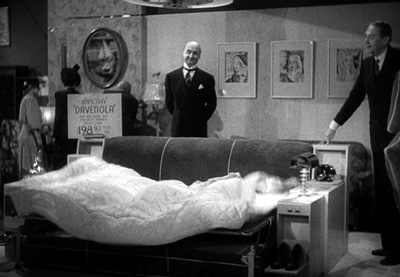
Push button technology that includes a reading lamp, a radio and a self-fluffing mattress–
all for the low, low price of $198.50! Try getting a couch for that now.
Out of all the Sturges films I’ve seen, I have to say that Christmas in July has become one of my favorites. Clocking in at under 67 minutes, it’s not only funny and witty, but Sturges shows how the sudden accumulation of money changes the opinions of others who would have treated the couple like a bunch of nobodies beforehand. In that respect, Christmas in July is pretty depressing: money changes you in the eyes of others. It’s a sad, but true realization. Jimmy and Betty are the same people, only richer and yet, everyone fawns over them as though they’re newfound royalty. That is–until it’s revealed that Jimmy’s winning was a joke and suddenly, Jimmy is a “criminal” to those that had just fawned over him. It’s quite hypocritical.
Living the Good Life: Ellen Drew and Dick Powell in Christmas in July
I didn’t realize it until the other day, but Union Depot and Christmas in July are quite similar in tone. What makes them work is the ability for the audiences to identify with their characters: Ruth and Chick or Jimmy and Betty. Both stories are representative of their eras. With Ruth and Chick, they’re just struggling to make it through the depression like everyone else. And with Jimmy and Betty, they’re both working just to make ends meet, in hopes that one day they’ll be able to afford a better life. When both couples come into money, the first thing they do is splurge: a big meal for Chick and some new clothes for Ruth, while Jimmy and Betty run down to the local department store and buy an engagement ring. But despite their wealth, the one thing that really draws you into both stories is love. You get the feeling that each couple could wind up poor and still find a way to make it. Love is stronger than money and the tense situations that test each couple afterwards, prove it.
And that’s the beauty of the one hour movie: a big plot and good acting packed into half the time that a regular movie would take. Sure there are some clunkers, but there are hidden gems as well. The studios cranked these movies out like clockwork out only to fill out double bill features and to meet quotas that theaters set. But what the studios didn’t realize is that in some of these little films, such as Union Depot and Christmas in July, were just as uplifting and entertaining as an top-billed movie, maybe even more so. By the time the 60’s rolled around, the “programmer” was pretty much obsolete and that’s a shame. Thank goodness they’re still around for us to watch today. Although times have changed, good films haven’t and sometimes, you just need a little cinematic pick-me-up that only a well-crafted b-movie programmer can provide.
Read Full Post »

















